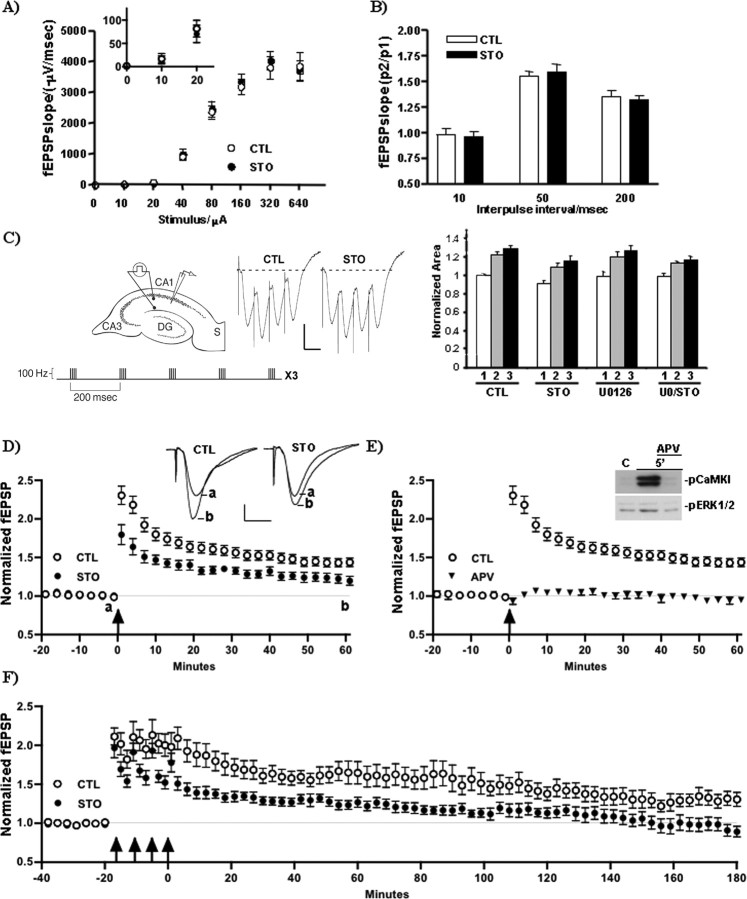Figure 2.
Inhibition of CaMKK markedly attenuates NMDA receptor-dependent LTP. A, STO-609 does not affect basal synaptic transmission. Input-output relationship for Schaffer collateral stimulation and fEPSP initial slopes recorded from area CA1 of mouse hippocampal slices preincubated without or with 5 μm STO-609 (STO) for 30 min. Inset, 0-20 μA; n = 8. B, Paired-pulse facilitation is normal during STO-609 treatment. Paired-pulse facilitation at 10, 50, and 200 ms interpulse intervals. Values presented are ratios of fEPSP initial slopes (pulse 2/pulse 1). n = 8. C, Left, Schematic drawing of electrode placements during recording and E-LTP induction paradigm (see Materials and Methods). DG, Dentate gyrus; S, stratum radiatum. Middle, Representative first burst responses from mock-treated (control) and treated (STO) slices. Calibration: 0.5 mV, 10 ms. Right, Integrated dendritic theta-burst responses of control slices and treated slices: n = 24, control; n = 11, STO-609; n = 10, U0126; n = 10, U0126 plus STO-609 UO/STO. The theta-burst responses were calculated by integrating the fEPSP response during stimulation of naive slices with our E-LTP-generating protocol. D, E, Inhibition of CaMKK partially inhibits NMDA receptor-dependent E-LTP. After 20 min of stable baseline recording (1 test pulse per minute min), slices were treated for 30 min without or with 5 μm STO-609 for 30 min (D) or with 50 μm APV for 20 min (E) before and 5 min after theta-burst stimulation [4 pulses per burst (100 Hz), 5 bursts pertrain (5Hz), 3 trains (20s apart)]. STO-609 had no significant effect on baseline fEPSP amplitude or initial slope kinetics. Control slices (LTP, 144 ± 5.4%; n = 24) exhibited approximately two fold greater LTP than STO-treated slices (LTP, 120 ± 5.9%; n = 11) at 60 min, whereas APV treatment (n = 8) completely blocked LTP. D, Inset, Average of 10 responses, 1-10 min before (a) and 50-60 min after (b) LTP induction. E, Inset, Western blots from microdissected region CA1 showing pCaMKI and pERK 5 min after mock stimulation (control) or theta-burst stimulation without or with APV treatment. F, Inhibition of CaMKK blocks L-LTP. Slices were treated without or with STO-609 as in D before stimulation with recurrent theta-burst patterned activity [4 pulses per burst (100 Hz), 5 bursts per train (5 Hz), 6 trains (20 s apart), 4 epochs (5 min apart)] to generate late-phase LTP. Control, n = 6; STO-609, n = 6. CTL, Control.

